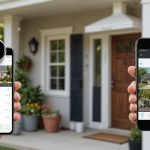Overview of Smart Lighting Technologies
Smart lighting is a crucial element in home security solutions and safety enhancements. It operates by connecting light fixtures to a network, allowing users to control lighting via smartphones or voice-activated devices. A key feature of smart lighting is automated scheduling, which enables lights to simulate occupancy when the home is vacant, thereby deterring potential intruders.
Numerous smart lighting technologies exist to cater to diverse security needs. Popular options include smart bulbs that connect via Wi-Fi, enabling remote access and control. Smart switches offer an integrated solution, replacing traditional switches to automate existing light fixtures. Additionally, colour-tunable lights can change hues based on user preferences or adaptive lighting needs.
Also to discover : Essential Apps for Effortless Control of Multi-Room Smart Home Audio Systems
Integrating smart lighting with home security systems delivers several benefits. For instance, smart lighting can sync with security cameras and alarms, illuminating essential areas when suspicious activity is detected. This not only enhances visibility but also provides safety enhancements by ensuring critical zones are well-lit during emergencies. Moreover, these systems can offer peace of mind and bolster property protection.
In summary, incorporating smart lighting into home security setups augments safety enhancements and furnishes an effective deterrent against unauthorised access, proving its indispensability in contemporary security frameworks.
Have you seen this : Stay Informed: Receive Instant Smartphone Notifications from Your Smart Home Security Cameras
Practical Smart Lighting Solutions for Enhanced Security
Smart lighting options provide a versatile approach to bolstering home security and ensuring enhanced safety. Each type of smart lighting serves a unique purpose while contributing to a comprehensive security strategy.
Motion-Activated Lighting
Motion-activated lighting acts as a formidable deterrent against intruders by illuminating areas when movement is detected. These lights conserve energy by activating only when needed, making them both practical and efficient. They can be strategically placed around entry points or dark corners to enhance visibility and alert homeowners to unexpected activity.
Smart Bulbs and Fixtures
Smart bulbs and fixtures offer flexible control, allowing users to adjust lighting conditions remotely. These can be programmed to turn on and off at designated times, creating the illusion of occupancy, thus deterring potential break-ins. Options range from simple plug-and-play bulbs to more sophisticated integrated fixtures compatible with existing systems.
Landscape Lighting
Landscape lighting enhances both safety and aesthetic appeal. By illuminating pathways and gardens, it reduces the risk of accidents while also highlighting potential hiding spots that intruders might exploit. Selection ranges from solar-powered options to wired systems, ensuring adaptability to the specific layout and requirements of any property.
Installation Tips for Smart Lighting Systems
Setting up a smart lighting system can be a straightforward process with some preparation and understanding. To begin, assess your home setup requirements to determine the best locations for smart lights, ensuring optimal safety enhancements. A strategic placement of these lights can amplify your home security significantly.
When ready to install, start by replacing traditional bulbs and switches with their smart counterparts. For an efficient smart lighting installation, follow the manufacturer’s instructions, often available through built-in guides or companion apps. Ensure compatibility between the lighting devices and your home network for seamless connectivity.
A common challenge during installation could be connectivity issues. To troubleshoot, consider the distance between your lighting devices and Wi-Fi router. In some cases, a Wi-Fi extender might solve signal drop issues, facilitating uninterrupted operation.
Additionally, precise placement plays a pivotal role. For instance, install security-focused lights at entry points and exterior walkways to maximise visibility and deter intruders. By following these guidelines and leveraging DIY security initiatives, you can enhance safety without professional help, making smart lighting installation both cost-effective and practical.
Integrating Smart Lighting with Existing Security Systems
Integrating smart lighting with existing security systems can significantly enhance a home’s safety and automation capabilities. This synergy between smart lighting and security technologies, such as security cameras and alarms, ensures comprehensive home security solutions by illuminating critical areas during potential threats. Moreover, the integration enables seamless communication among devices, thus providing synchronized responses to unusual activities.
To achieve effective smart lighting integration, selecting compatible products becomes crucial. Many homeowners prefer systems like Philips Hue or LIFX that offer easy connectivity with popular home automation platforms such as Amazon Alexa, Google Assistant, and Apple HomeKit. These systems facilitate a user-friendly interface to manage both lighting and security, creating a cohesive setup.
The benefits of a unified system extend beyond mere convenience. A centralized control platform empowers homeowners to oversee their entire security environment, enabling real-time adjustments to lighting conditions based on alerts from the security systems. This holistic approach enhances situational awareness and strengthens deterrents against intrusions. The intelligent interaction between these technologies promises not only improved security but also elevates the overall living experience by creating a smart, responsive home environment tailored to individual needs and preferences.
Energy Efficiency in Smart Lighting
In today’s eco-conscious world, energy efficient lighting is vital not only for cost savings but also for its environmental benefits. Smart lighting represents a significant advancement over traditional solutions, offering enhanced functionality with reduced energy consumption. One of the primary ways smart lighting achieves this is through automated control, allowing lights to be scheduled or activated via sensors, based on presence or time of day. This precise control minimises unnecessary energy use.
When comparing traditional lighting to smart lighting options, the difference in energy efficiency becomes apparent. Traditional incandescent bulbs consume significantly more electricity, while smart LEDs use far less power and have a much longer lifespan. This shift not only reduces electricity bills but also lowers the carbon footprint, contributing to eco-friendly solutions.
To optimize energy use while ensuring security, consider using motion-activated lighting near entry points and dimmers to adjust brightness levels according to natural light availability. By investing in smart lighting, homeowners can reap long-term cost benefits. Reduced energy consumption helps to achieve measurable savings on utility bills, while integration with a home automation system ensures lights are only used when necessary, further enhancing cost efficiency and sustainability.
Real-life Case Studies and Testimonials
Exploring smart lighting success stories and user experiences reveals practical insights into its transformative impact on home security. One notable case study features a homeowner who integrated smart lighting with a comprehensive security system. By employing motion-activated lights and automated schedules, they achieved a significant reduction in break-in attempts, underscoring the effectiveness of smart lighting as a deterrent. Testimonials from this user highlight the seamless integration and intuitive control offered by smart systems, contributing to a heightened sense of security.
In another example, a family utilized smart landscape lighting to illuminate potential entry points and dark spots around their property. Their account reveals reduced energy costs thanks to solar-powered options, enhancing eco-friendly credentials without compromising safety.
Further user testimonials commend the adaptability of systems like Philips Hue, which allow personalization through adjustable brightness and colourful ambiance. This user-centric flexibility aligns with diverse preferences, as users can tailor lighting settings according to specific security needs and aesthetic interests.
The overarching lesson from these real-life applications emphasizes that investing in smart lighting not only fortifies property security but also enhances user convenience, proving to be a reliable and efficient enhancement to traditional security measures.
Product Comparisons and Recommendations
When selecting smart lighting products, key factors include features, usability, and price. The most efficient solutions for home security balance these elements, offering flexibility and control for homeowners.
Best Smart Bulbs
Smart bulbs like Philips Hue offer versatility and seamless integration with smart home platforms. These bulbs support voice commands and mobile app control, enhancing ease of use. Hue’s energy-efficient design and customisable lighting features make it a popular choice for both home security solutions and aesthetic enhancement.
Top Motion Sensors
For robust home security, motion sensors like Ring and Arlo stand out. These devices excel in detecting activity, triggering lights when movement is perceived, thus acting as a deterrent. Key considerations include sensor range, response time, and compatibility with existing systems, ensuring comprehensive protection.
Leading Smart Floodlights
When prioritising safety enhancements, smart floodlights like the Eufy Security Floodlight Cam offer integrated video surveillance with illumination. These floodlights are equipped with cameras for real-time monitoring, providing reliable security features. Evaluating aspects like video quality, brightness, and installation ease can guide homeowners to select the optimal floodlight solution tailored to their specific needs.





